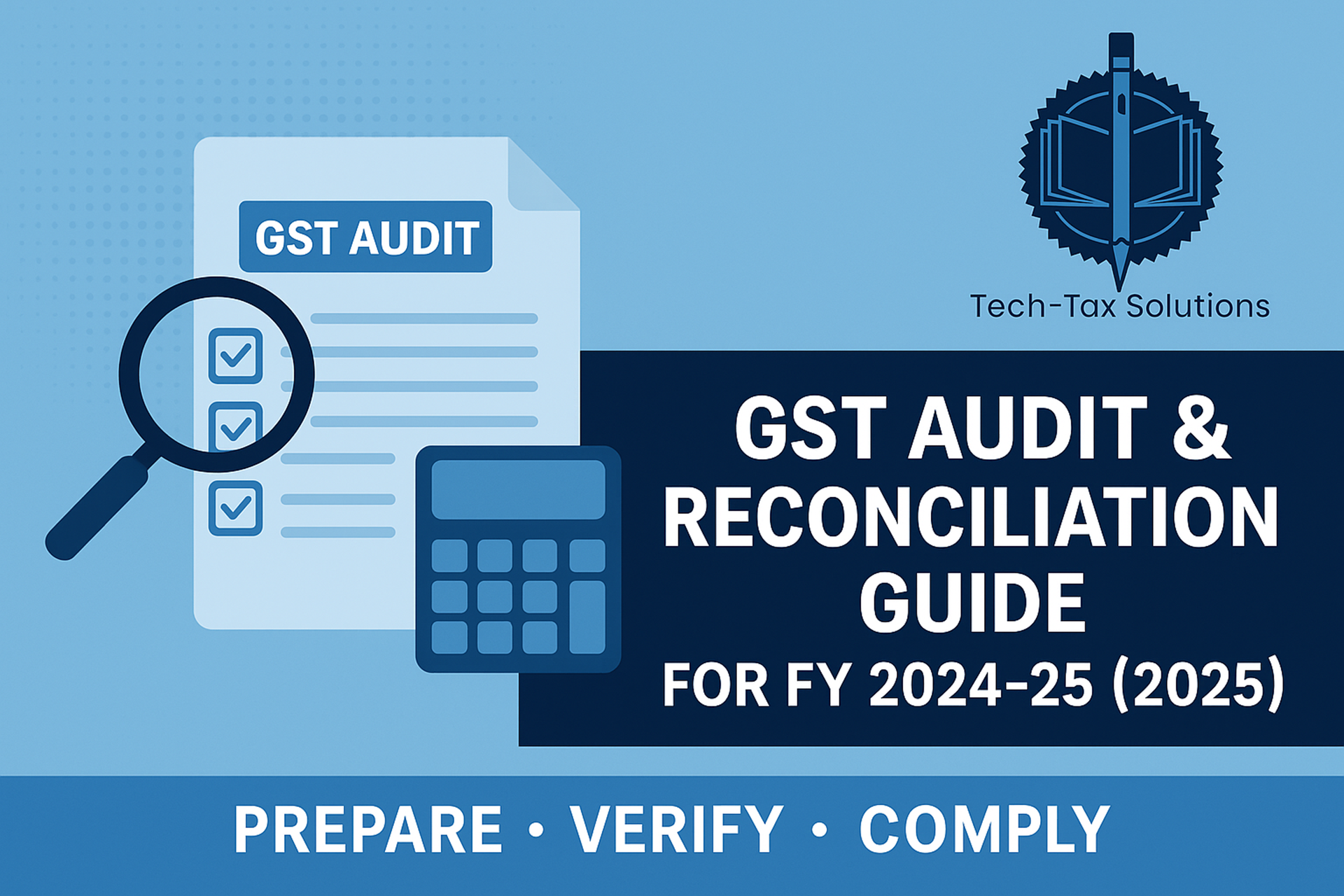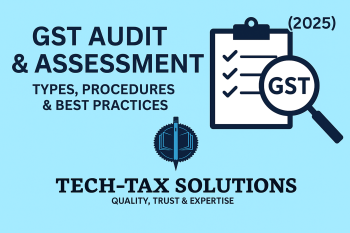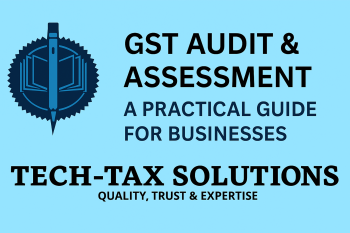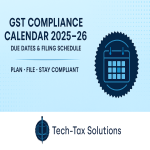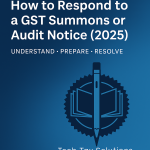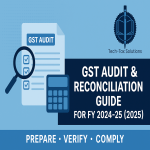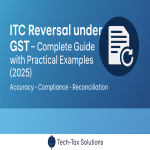🔹 Introduction
As the financial year 2024–25 concludes, businesses across India are preparing for their GST audit and annual return filing. Proper reconciliation and documentation ensure that your GST filings align with your books of accounts, minimizing the risk of penalties, notices, or scrutiny under Section 65 of the CGST Act.
This comprehensive guide explains the GST audit and reconciliation process, key compliance steps, and practical strategies to prepare your GSTR-9 and GSTR-9C efficiently for FY 2024–25.
🔹 Legal Framework
GST audit and reconciliation requirements are defined under:
-
Section 65 of the CGST Act, 2017 – Departmental GST audit by tax authorities.
-
Section 35(5) (omitted but conceptually relevant) – Mandated audit for specified taxpayers.
-
Rule 80(1) & (3) of the CGST Rules, 2017 – Annual return (GSTR-9) and self-certified reconciliation statement (GSTR-9C).
-
CBIC Notification No. 30/2021 – Central Tax – Introduced self-certification instead of CA attestation for GSTR-9C.
📘 Objective:
To ensure that turnover, ITC, and tax payments declared in GST returns are accurate and match audited financial statements.
🔹 Who is Required to File GSTR-9 and GSTR-9C (FY 2024–25)
| Form | Applicability | Threshold / Remarks |
|---|---|---|
| GSTR-9 | All regular taxpayers | Mandatory (turnover > ₹2 crore recommended) |
| GSTR-9C | Taxpayers with turnover exceeding ₹5 crore | Self-certified reconciliation statement |
| Composition Dealers (GSTR-4) | Not applicable | File annual return in Form GSTR-4 |
| Casual/Non-resident/ISD/TDS deductors | Exempt | No GSTR-9 filing required |
💡 Due Date:
31st December 2025 (for FY 2024–25), unless extended by CBIC.
🔹 Key Components of GST Reconciliation
✅ 1. Outward Supply Reconciliation (Sales Data)
-
Match turnover as per books with GSTR-1 & GSTR-3B.
-
Identify unreported or double-reported invoices.
-
Verify credit notes, debit notes, and advances.
📊 Tip: Generate a “Turnover vs Return Filed” comparison report.
✅ 2. Input Tax Credit (ITC) Reconciliation
-
Match ITC as per GSTR-3B with GSTR-2B and books.
-
Identify ineligible ITC under Section 17(5).
-
Reverse ITC not supported by supplier filings (Rule 37A).
-
Reconcile ITC carried forward from the previous year.
📌 Result: Ensures only eligible ITC is claimed and reduces risk of DRC-01 notices.
✅ 3. Tax Payment & Liability Reconciliation
-
Verify tax paid (IGST, CGST, SGST) in GSTR-3B vs books.
-
Cross-check payments in the Electronic Cash Ledger.
-
Ensure any interest or late fees have been discharged.
✅ 4. Other Reconciliations
-
E-way Bill data vs GSTR-1 (to identify unreported movements).
-
HSN Summary vs books (for accuracy in GSTR-9 reporting).
-
Advances adjusted vs returns filed.
🔹 Step-by-Step GST Audit Preparation Guide
Step 1: Download and Organize Data
-
Download GSTR-1, 3B, and 2B for all 12 months.
-
Extract sales/purchase ledgers and trial balance from your books.
Step 2: Perform Return-wise Reconciliation
-
Match books vs returns for turnover, ITC, and tax payments.
Step 3: Identify Differences and Reasons
-
Missing invoices, wrong GSTIN, ineligible ITC, or tax rate mismatch.
Step 4: Make Voluntary Corrections
-
Report unclaimed ITC or excess liability via DRC-03 before filing annual return.
Step 5: File GSTR-9 and GSTR-9C
-
Use pre-filled data on GST portal.
-
Reconcile auto-populated details with audited financials.
-
Self-certify GSTR-9C and upload supporting documents.
🔹 Common Errors Found During GST Audit
❌ Difference between GSTR-1 and GSTR-3B turnover.
❌ ITC claimed not appearing in GSTR-2B.
❌ Unreversed ITC for unpaid invoices beyond 180 days.
❌ Missed outward supplies due to manual invoicing.
❌ Wrong GST rate applied in sales/purchase books.
🔹 Penalties for Non-Compliance
| Default | Consequence |
|---|---|
| Failure to file GSTR-9 | ₹200 per day (₹100 CGST + ₹100 SGST) – Max 0.25% of turnover |
| Incorrect filing / mismatch | Demand notice under Section 73/74 |
| Failure to reconcile ITC | Interest @18% and reversal demand |
| Not maintaining audit records | Penalty under Section 125 |
🔹 Best Practices for a Smooth GST Audit
✅ Conduct quarterly reconciliations instead of waiting till year-end.
✅ Maintain invoice-wise ITC register with GSTR-2B linkage.
✅ Reconcile e-way bill, GSTR-1 & books monthly.
✅ Use reconciliation tools or automation for large data sets.
✅ Preserve records for 6 years (as per Section 36).
🔹 Practical Example
Case Study:
M/s Rapid Manufacturing Pvt. Ltd. (Turnover ₹12 crore) found ITC of ₹2.5 lakh unmatched in GSTR-2B due to supplier default.
They voluntarily reversed ITC via DRC-03, reflected in annual return, and avoided a DRC-01 notice during audit.
📊 Lesson: Proactive reconciliation prevents departmental disputes.
🔹 FAQs
Q1. Is GST audit by a Chartered Accountant still mandatory?
➡️ No, from FY 2020–21 onwards, GSTR-9C is self-certified by taxpayers.
Q2. What is the due date for GSTR-9 and 9C for FY 2024–25?
➡️ 31st December 2025 (subject to extension by CBIC).
Q3. What documents are required for GST audit?
➡️ GSTR-1, 3B, 2B, annual financials, purchase/sales register, e-way bill data, ITC ledgers.
Q4. Can differences between books and GST returns be adjusted now?
➡️ Yes, voluntary corrections can be made through Form DRC-03 before filing GSTR-9.
Q5. Can Tech-Tax Solutions help in GST audit preparation?
➡️ Yes, we specialize in GST reconciliation, GSTR-9/9C filing, and audit defense support for businesses across India.
🔹 Conclusion
A well-prepared GST audit and reconciliation ensures transparency, compliance, and peace of mind.
By aligning books with returns and resolving mismatches proactively, businesses can avoid penalties and maintain a strong compliance rating.
📌 For expert GST audit and reconciliation support, connect with Tech-Tax Solutions – Quality, Trust & Expertise in Ghaziabad, Noida & Delhi.
